During the Stalinist times, the prison on Rakowiecka was gloomy, and the prisoners who ended up there were aware that this might be their last journey. The prisoners were tortured and mentally tormented. They were sentenced to death on the basis of circumstantial evidence.
The prison was built in the years 1902-1904 on the orders of the Russian authorities, it functioned during the German occupation during World War II, but it was the worst famous during the Stalinist period. It then became a place of execution for many patriots and heroes, including captain. Witold Pilecki and General August Emil Fieldorf "Nil" . Bodies of murdered political prisoners were secretly buried, incl. in Służew and at the wall of the Municipal Cemetery in the so-called the quarters in "Łączka". Many of them have not been found until today.
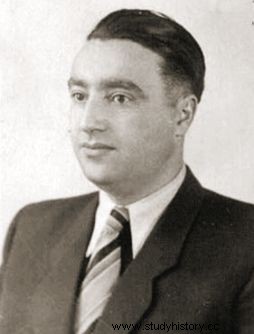
Józef Light described the functioning of the X Department after his escape to the West
For many years the prison was shrouded in mystery. Terrible things have been said about him, although reliable information was lacking. Even if someone left it, he did not dare to talk about it in the atmosphere of Stalinist terror. In some, the fear remained for life. The shocking partial truth was revealed only in his broadcasts on Radio Free Europe, Lt. Col. Józef Light, deputy director of Department X of the Ministry of Public Security, who fled west in September 1953. He could talk about it, because he knew the prison reality perfectly well, and at the same time he was safe beyond the reach of the Polish security service.
Pavilion X
Pavilion X aroused particular fear among prisoners. It was subordinate to the Investigative Department of the Ministry of Public Security. It was here that the heroes of the fights with the occupant, accused of collaboration or hostile activity against the communist state, were kept. In prison torture rooms, they were forced to confess by cruel torture. It was humiliating for the soldiers of the independence underground that after the end of the war they were sitting in cells together with Nazi criminals.
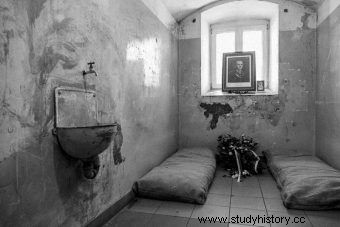
Museum of the Cursed Soldiers and Political Prisoners of the People's Republic of Poland. Illustrative photo.
The cells in this pavilion were 2 × 3.5 meters. Before the war, individual rooms were intended for one person, during Stalinism even eight were placed in them. There were no beds, the prisoners slept on mattresses spread out on the concrete floor. This is how Dr. Franciszek Chmielewski described his cell:
The cell was dirty, one glass was partially broken, cold, the desk was empty - I found one paperclip in it, but no trace of paper, the toilet was flushed with no cover. I saw various inscriptions on the walls. [...] The blanket was thin, with holes, a bit of chopped straw in the so-called headboard and sheet
They wake up at 5 a.m., the prisoners are mistaken in the toilet in the corner of the cell and after a few minutes they had to attend the roll-call:
We washed in the toilet. […] The morning roll-call took place a few minutes after waking up. The duty officer with the ward opened the cells and checked the personal status. At that time, we stood at attention in a row against the wall, in our underwear and barefoot. After that, we were allowed to take our shoes and clothes from the corridor, which, after the evening roll call, we had to put into neat cubes outside the cell door.
Breakfast (a cup of cereal coffee and a piece of bread) was served at 6 o'clock and from 7 o'clock the prisoners were interrogated.
The interrogations were particularly cruel. Sadistic torturers, taught by their teachers from the USSR, had a simple way of forcing a prisoner to plead guilty - beating. One of the prisoners recalled the interrogations as follows:
I was beaten with fists and a ruler - on the face and hands, and on my legs under the knees with a metal bar. As my muscles went numb and I fell, I was kicked up. People dug wherever they fell, preferably in the groin. When my tormentors found that the beating did not work for me anymore, they reached for others. My hands and feet were tied and put on a hook, so that my back was against the wall and my stretched, bound legs rested on a stool. God, what a horrible torture it is . The entire weight of the body rests on the centimeter-thick tip of a bent hook hammered into the wall. In addition, they seat you so that you lean on your tailbone. Even slight movement causes the hook to dig into the rectum. How many times have I passed out during this operation ...
The mode of interrogation depended on the investigating officers. Some were relatively short, but frequent. Others went on forever, and only the interrogators changed. Some of them lasted even several or several dozen hours.
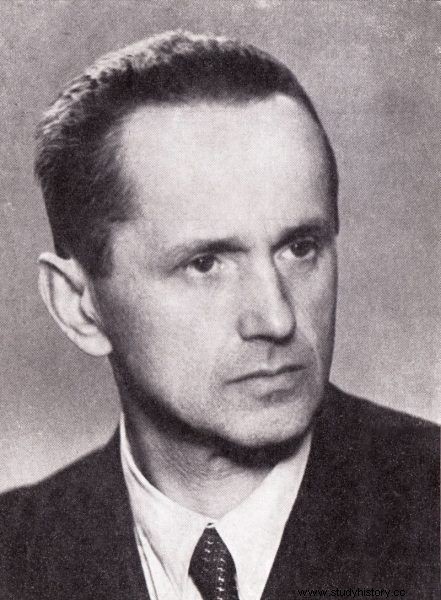
One of the longest held political prisoners was Kazimierz Moczarski
Prisoners were not only beaten, but also mentally abused. Interrogating over and over for the next few days - lack of sleep made you lose your sense of reality. Some sadistic officers were credited with inhuman interrogation methods - sitting on a stool leg, jumping for hours, tearing nails or sticking splinters there.
One of the longest-held political prisoners of the Stalinist period was Kazimierz Moczarski. He spent ... 11 years there:
You, Mr. Moczarski, will go to the ground anyway, because you know perfectly well that the court is at our service and that we have put a cross on you here - whether you are guilty or not.
In his memoirs, Moczarski described several dozen types of torture to which he was subjected.
The prisoners were humiliated for actual or imaginary offenses. Even after his release from prison, his appearance confirmed the tragedies he had experienced. During the rehabilitation process he had his fingers trampled underfoot, burned hands, lumps on his face.
It was not ordinary policemen who attacked us in rage and nervousness. It took mastery to create an apparatus so well-coordinated and trained in Katowice craftsmanship, from the rank of a colonel or even a general to an ordinary guard in the prison corridor. What an artist in his profession Colonel Józef Dusza was:he was able to jump with a police rubber truncheon at the bridge of the nose without breaking bones.
Capital punishment for circumstantial evidence
Under the Stalinist penal code, an admission of guilt was treated as a proving of guilt and was sufficient for the pseudo-court as a reason for conviction. Most often, this admission was, of course, forced through harassment and torture.
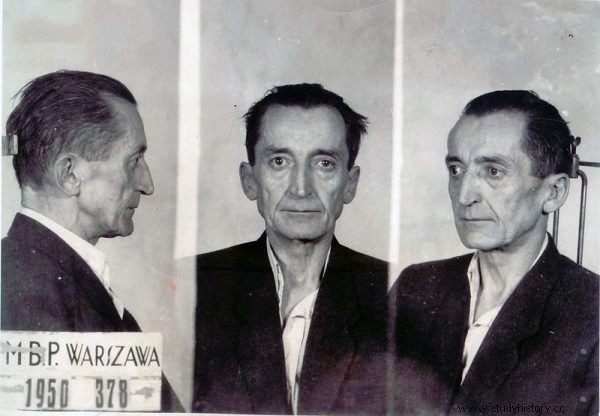
Emil Fieldorf after his arrest in 1950
Fake trials without the presence of a lawyer lasted several minutes in prison and could end with a death sentence . They were often held in cells, and during their duration the inmate sat on the toilet (hence they were called tilts) .
In the years 1945–1956 350 people died in the prison on Rakowiecka Street. Among them were the heroes of the fights with the German occupier, such as:Capt. Witold Pilecki (murdered on May 25, 1948), a man who voluntarily went to Auschwitz to find out the truth about the situation in the camp and organize a resistance movement there, Major Hieronim Dekutowski "Zapora" (executed on March 7, 1949, found in headquarters "Ł" in 2012), Lt. Col. Łukasz Ciepliński "Pług", the last president of WiN (executed on March 1, 1951) and the deputy commander of the Home Army, General August Emil Fieldorf "Nil" (execution by hanging was carried out on February 24, 1953).
Maj. Stanisław Skalski, the hero of the Battle of Britain, was also sitting on Rakowiecka Street . Polish soldiers who returned to the country after the war were treated as potential spies and harassed by the authorities. Those who were not arrested were constantly under surveillance (the action was codenamed "Andersowcy").
The fate of General Fieldorf is particularly telling, testifying to the perfidy of the authorities at the time. Sam reported to the Stalinist authorities, trusting in assurances that people who revealed themselves would not be punished. It was another communist lie. What is particularly shameful, the Stalinist torturers accused him of collaborating with the Nazi occupiers during the war, acting to the detriment of the Polish state.
He was sentenced despite the fact that the general's father asked Bierut for pardon. The president has not exercised this right. He did it extremely rarely. In 2017, the probable gallows on which the "Nile" was murdered were found in prison. This is just one of many examples of the persecution of World War II heroes who could not come to terms with the new system in Poland.
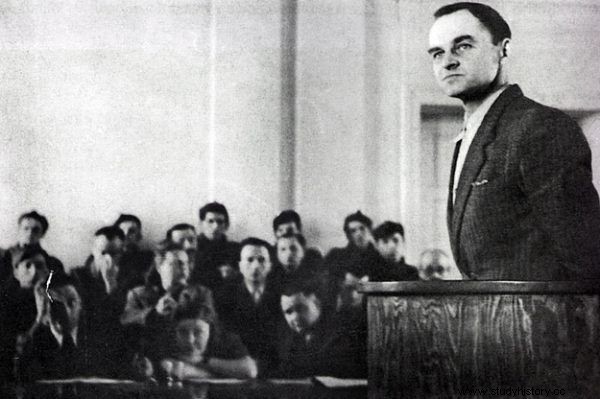
In the torture chamber in Mokotów, among others, rtm. Witold Pilecki
Convicts waited on death row, sometimes for several months, waiting for the execution or pardon, which was additional torture. Death sentences were carried out inside the prison. Admittedly, the management of the prison administration issued an instruction in 1945 specifying how it should proceed in order to ensure the convict with a minimum of dignity. For people knew perfectly well that prisoners are brutally killed , very often on stairs or basement rooms with a shot in the back of the head. Therefore, a recommendation was issued to “civilize” this practice. Of course, the reality was far from the recommendations and the practices so far continued throughout the Stalinist period.
Prisoners were punished for the slightest offenses. One form was placement in a punishment room. It was a small room with no window in which the prisoner was kept naked. He rarely had a chance to get out, even if he wanted to use the restroom. So he necessarily had to take care of the physiological needs of the floor, which, of course, was not then cleaned. After the sentence, prisoners sentenced to long prison terms were transported to other centers:Wronek or Rawicz.
Mokotów Anthem
The bitter testimony of these events is the so-called Mokotów Anthem . To the melody of the Red Poppies on Monte Cassino on death row, the words were written by a WiN member - Karol Chmiel, "Grom", "Zygmunt", "Katonowicz", "Leon". He was murdered on March 1, 1951.
Can you see these red walls
It is the dread and the torment of home
Today our suffering is judged in him,
But tomorrow it will be thundered with vengeance.
This is where the Polish idea of the First Underground Army sits today. Flower
What with your work on Polish soil
They want to make the world more beautiful.
Red walls of bloody Mokotów They hide the secrets of the bars.
Evidence words forced here
And the martyrdom of past years.
Years will pass and words will pass
That song of prison years
And only on the walls of the red Mokotów district
A trace of clotted blood will remain.
The prison in Mokotów functioned until the end of the socialist system in Poland. Of course, the worst period in its history was during the Stalinist period. The bad reputation continues today.
